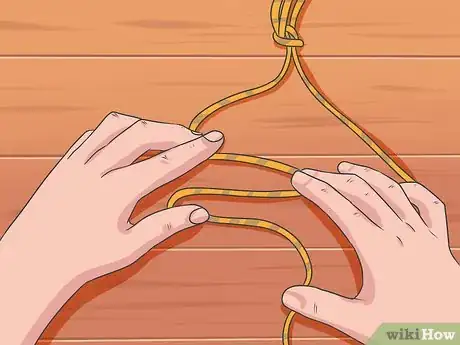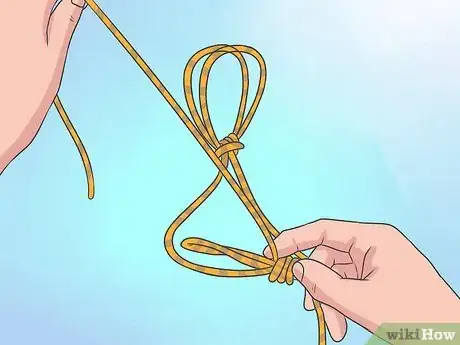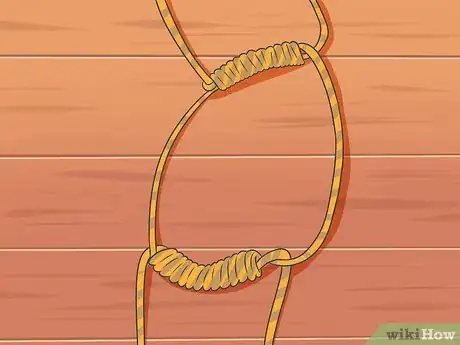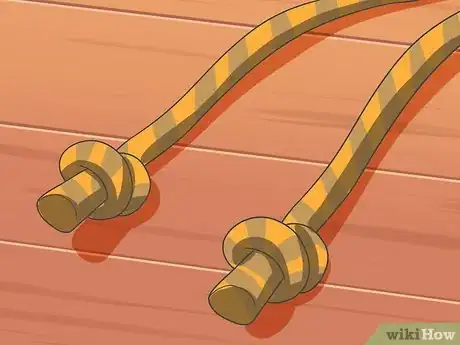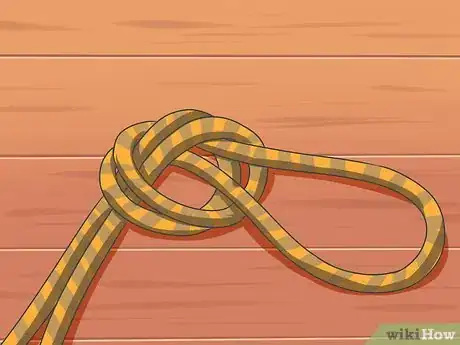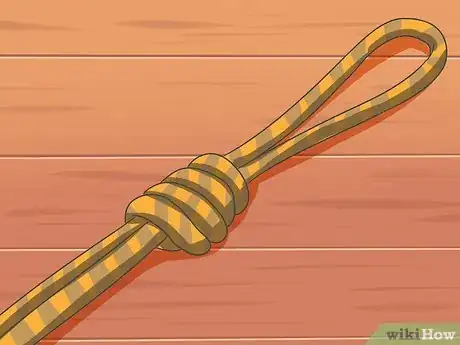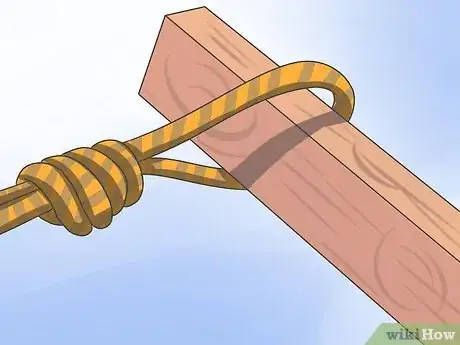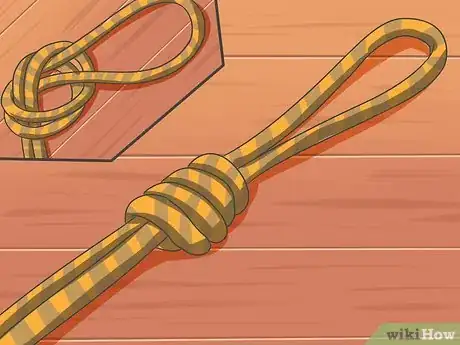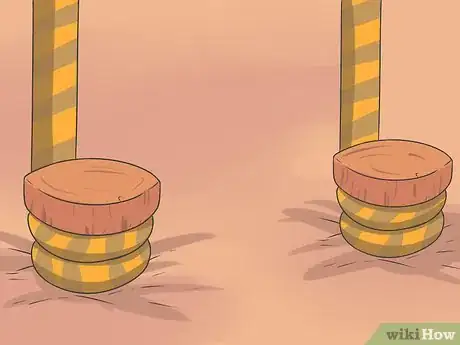wikiHow is a “wiki,” similar to Wikipedia, which means that many of our articles are co-written by multiple authors. To create this article, 22 people, some anonymous, worked to edit and improve it over time.
There are 9 references cited in this article, which can be found at the bottom of the page.
This article has been viewed 265,662 times.
Learn more...
Knowing how to make a rope ladder is a very handy skill. Not only do they have a practical use in outdoor activities such as boating and hiking, but they’re a lot of fun to climb, too. Additionally, they may be used as an emergency resource where traditional ladders are unavailable, impractical, or unwieldy.
Steps
Making A Basic Single-Rope Ladder
-
1Set a single length of rope down on a flat surface and form it into a "U" shape. Take hold of the rope on the end of the right side of the "U" and slide your hand down the rope to measure out 1 foot (30 cm) of rope. [1]
-
2Position the rope between your two hands into an "S" shape. Bring your hands together to squish the "S" down horizontally. [2]Advertisement
-
3Make the first rung of the ladder by taking the left end of the rope and threading it through the first, left bend of the "S." Bring the end of the rope under the bottom curve, wrapping it around the whole "S" four times. Feed the end of the rope through the second, right bend of the "S" to secure the tie and complete the first rung. [3]
-
4Repeat this as many times as you need to create the rope ladder to your desired length.
Making a Rope Ladder With Wooden Rungs
-
1Prepare two lengths of rope by binding or melting them at the ends. Do this to prevent your newly cut rope from fraying or unraveling.
- Binding the ends of a rope is called whipping. Take some twine and run it along the length of the rope until you almost get to the rope’s end. Double back when the length of the twine is equal to around one and a half times the diameter of the rope. The twine should form an upside down “U” shape. Wrap the twine tightly along the “U”, and put the end of the twine through the loop at the top. Now, pull both ends of the twine until the loop is pulled underneath the whipping. Cut the ends of the twine so that they don't stick out and the whipping looks neat. [4]
- It is best to use natural fibre twine when whipping natural fibre rope as it will be less likely to slip off. [5]
- If you are using a synthetic rope, wrap the ends with some tape, then melt them over a flame. [6]
-
2Lay the rope flat on the ground, and make an overhand loop around 15 inches (38 cm) from the top-end of your rope. To make an overhand loop, take the working end of the rope and place it over the standing part. This loop is the first step of forming the knot which will hold the first wooden rung.
-
3Pull the standing part through the overhead loop. To do this, first put your fingers through the underside of the loop, and grasp the standing part. Now, pull the standing part through the overhead loop. This should form a new loop.
-
4Insert a wooden rung into the new loop formed by the standing part and tighten the rope. Move the rung into the desired position, and tighten the rope. [9] The resulting knot should be visible on the top and the bottom of the rung.
- The rung will be fairly secure at this point, but tying an overhand knot beneath it will greatly decrease any likelihood of the rung moving down the rope. To tie an overhead knot, make an overhand loop, then pass the working end over, then through the loop. [10] Make sure the overhand knot is directly below the knot supporting the rung.
-
5Repeat the process on the other length of rope. Take care to make sure that your rungs are level. Crooked ladder rungs will increase the likelihood of a fall.
-
6Start the next overhand loop anywhere from 9 to 15 inches (23 to 38cm) from the previous wooden rung. Space your rungs uniformly, and in a manner that will allow you to climb comfortably. Keep adding rungs until your ladder reaches the desired length. [11]
-
7Secure your ladder at the top. To do this, use either a timber hitch or a rolling hitch knot.
- To tie a timber hitch, wrap the working end around the pole or branch you intend to attach your ladder to all the way around once. Cross the working end over the standing part and continue to wrap the working end around the pole at least twice more. Pull the rope taut to tighten it. If you need more grip, wrap the working end around the standing part a few more times. A timber hitch is ideal for attaching a rope ladder because the greater the amount of pulling force exerted on the knot, the tighter it becomes. [12]
- To tie a rolling hitch, take the working end of the rope and wrap it completely around your stake at least three times. Take the working end and place it over the standing part. Now wrap the rope around the stake on the other side of the standing part a few times. Tuck the working end underneath the bit of rope which crossed over the standing part and pull it tight. A rolling hitch holds up very well against a horizontal pulling force, so it is ideal if you are attaching your ladder to horizontal stakes or poles. As with the timber hitch, if more grip is required, wrap the working end around the pole a few more times. [13]
-
8Secure your ladder at the bottom. This is optional, but securing your ladder to the ground will greatly increase its stability and make it easier to climb. [14]
- If you are going to secure your ladder to the ground, be sure to leave enough rope to do so; 15 inches (38cm) or more should do the trick.
- Wrap each leg of your ladder to a stake at a 45-degree angle and secure it with a rolling hitch.
Community Q&A
-
QuestionWhere can I buy a rope ladder?
 Community AnswerOnline is probably the best option. You may also want to check Home Depot or Lowe's.
Community AnswerOnline is probably the best option. You may also want to check Home Depot or Lowe's. -
QuestionCan you drill a hole at the rungs of a ladder and tie a knot underneath to stop the rung from slipping?
 Community AnswerYou can drill it as long as the rope is thick. You can't really tie a knot underneath. Instead, you could try digging it into the ground.
Community AnswerYou can drill it as long as the rope is thick. You can't really tie a knot underneath. Instead, you could try digging it into the ground. -
QuestionIs this strong enough for African grey parrots?
 Emma ErasmusCommunity AnswerYes, definitely. As long as you use proper rope and make sure the wood is safe, you should be fine.
Emma ErasmusCommunity AnswerYes, definitely. As long as you use proper rope and make sure the wood is safe, you should be fine.
Things You’ll Need
- Several feet/meters of rope
- Wooden rungs (optional)
- Lighter (optional)
- Tape (optional)
- Natural-fibre twine (optional)
References
- ↑ http://www.trails.com/how_13607_boy-scout-rope-ladder.html
- ↑ http://www.trails.com/how_13607_boy-scout-rope-ladder.html
- ↑ http://www.trails.com/how_13607_boy-scout-rope-ladder.html
- ↑ http://www.netknots.com/rope_knots/common-whipping
- ↑ http://www.netknots.com/rope_knots/common-whipping
- ↑ http://www.netknots.com/rope_knots/common-whipping
- ↑ http://scoutpioneering.com/2013/02/11/knot-tying-terminology/
- ↑ http://scoutpioneering.com/2013/02/11/knot-tying-terminology/
- ↑ http://scoutpioneering.com/tag/rope-ladder/
- ↑ http://www.indoorclimbing.com/Overhand_Knot.html
- ↑ http://scoutpioneering.com/tag/rope-ladder/
- ↑ http://scoutpioneering.com/2013/02/12/favorite-pioneering-knots-timber-hitch/
- ↑ http://scoutpioneering.com/2013/01/29/rolling-hitch/
- ↑ http://scoutpioneering.com/2013/03/17/making-a-rope-ladder/
- ↑ http://www.artofmanliness.com/2012/04/19/how-to-easily-create-your-own-rope-ladder/
About This Article
To make a basic single rope ladder, first lay out a rope in a U shape on a flat surface. About 1 foot (30 cm) below the curve of the U, grab the right side of the rope and bend it into an S shape. Take the left side of the rope and weave it over the top curve of the S, then behind the middle and bottom curves. Then, coil the left rope tightly around all 3 strands of the S about 12 to 18 times. Pull the remaining part of the left rope down through the loop sticking out at the right end of the wrapped S. Tighten the wrap by pulling the end of the right rope that’s sticking out at the left side of the rung. Repeat this process until you have completed as many rungs as you want. To learn how to make a rope ladder that has wooden rungs, keep reading!

